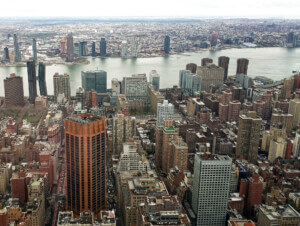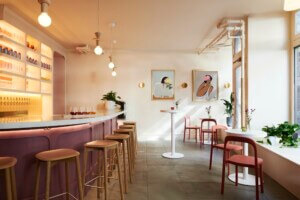The garment industry—and its district in west Midtown, New York—continues to be underappreciated within a city that has transitioned to one that consumes material goods rather than producing them. As recently as 2009, alternative zoning was proposed in an attempt to consolidate all the manufacturers into one building in the Garment District (see our 2009 article “Shrink to Fit”). This spring, the Economic Development Corporation (EDC), which supports manufacturers, proposed to eliminate the special zoning laws that promote the preservation of industrial space in the district. This current zoning overlay requires a one-to-one replacement of manufacturing space when (in general) a landlord converts space to commercial use, but it has been loosely enforced. While the proposal maintains the existing industrial zoning, it is not favored by the manufacturing community, Manhattan Borough President Gale Brewer, community boards, or groups such as the Garment District Alliance, Design Trust for Public Space, and the Municipal Art Society, among others. Together, these parties, who have requested additional time to review the proposal, have formed a steering committee in advance of the formal land-use review process (ULURP), slated to commence in August 2017.
The new proposal would also place limits on construction of new hotels in the area, which are considered “industrial use,” but has pressured industrial owners to sell. The city promises $15 million in technical assistance and costs for relocation into city-owned spaces in the Brooklyn Army Terminal ($100 million capital investment) or a future city-operated garment center building in Sunset Park ($136 million capital investment) to be completed in 2020. However, the synergy of the interdependent ecosystem of designers, contract manufacturers, suppliers, and distributors still has an irreplaceable value, even as it erodes.
Two alternate propositions:
Instead of removing the preservation requirements of the District’s zoning, I am proposing two scenarios to sustain the Garment District’s dense cluster of what I call “Vertical Urban Factories.” One approach could be to embrace the District’s organic mix of garment industries and residential, office, and retail space in a unique hybrid building type. Industrial preservation requirements could instead be tightened through “mandatory inclusionary manufacturing,” similar to the mayor’s plan for requirements for housing in newly rezoned areas.
Most mixed-use industrial districts (or “MX” districts) are proven to tip toward residential and commercial development because of the higher rents they command, and building owners profit from the industrial conversion to more lucrative uses. The Garment District is no different; it is an industrial zone, with other nonindustrial uses allowed. But since fashion is a lighter industry, like other niche design-driven industries, it is actually clean and quiet and can be easily integrated with office and residential uses in the same buildings. What if the higher-value residential tenants could consciously support the lower-rent garment tenants (or other light manufacturing spaces) through cross-subsidies? The result would be a diverse mix of making, selling, playing, and living; creating a 24/7 work-live community. The ground floor could remain retail space relating to the supplies that comprise the products—buttons, zippers, sequins, fabrics—while the lower and middle floors, where the showrooms are often located, would be required to be maintained as factories. The upper floors could contain the higher-value showrooms, and commercial and residential units. In reverse, new hotels could be required to house garment manufacturing, and guests could have a unique experience of watching manufacturing from their hotel rooms!
Another approach is to make the garment workers visible, injecting energy into the area with new physical transparency, exposing the industrial mysteries of workers making patterns, cutting, sewing, and pleating fabrics, in what I call the “consumption of production.” The emergence of industry-as-spectacle combines retail with making, so that the consumer also can see into the process from beginning to end, in our experience economy. This would be part of a longtime tradition of urban merchants and their workshops, or even the phenomenon of open kitchens in restaurants, and follows new interests in authenticity. In this new context, it combines another hybrid of retail-factory spaces for urban chocolatiers, coffee roasters, and bakers bringing street life to cities. In doing so, we can redefine and bolster the dynamism and diversity of our innovative and productive city.










